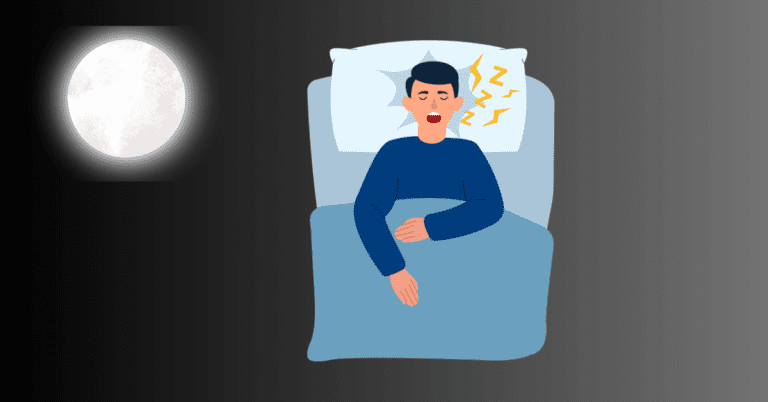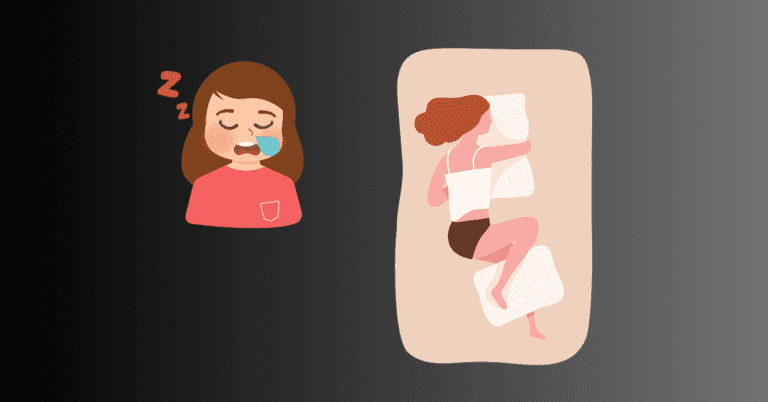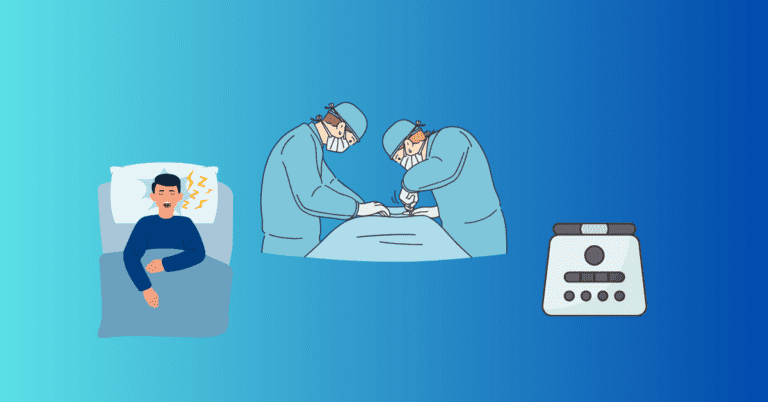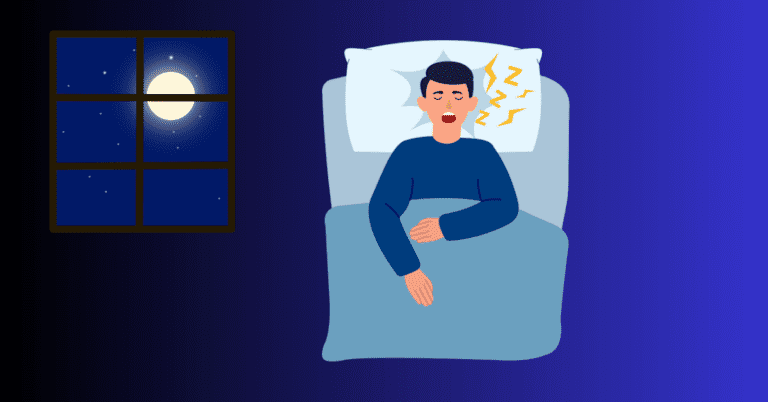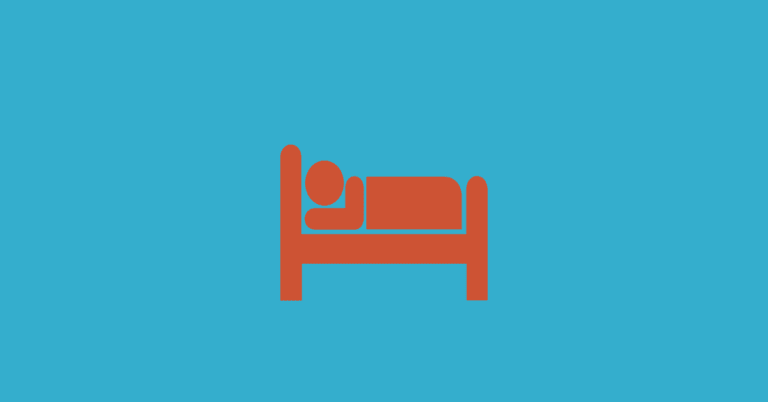Sleep Apnea Treatment: Your Guide to Managing Sleep Apnea
Sleep apnea is a common sleep disorder that affects millions of people worldwide including me. There are various sleep apnea treatments which I will discuss in this article.

Sleep apnea occurs when a person’s breathing is repeatedly interrupted during sleep, leading to poor sleep quality and serious health risks, such as heart disease, stroke, and diabetes.
While CPAP (Continuous Positive Airway Pressure) is the most well-known treatment for sleep apnea, there are many other options available.
In this comprehensive guide, we will explore the various sleep apnea treatment options, including lifestyle changes, devices, mouthpieces, surgeries, and special beds that can help improve your breathing during sleep.
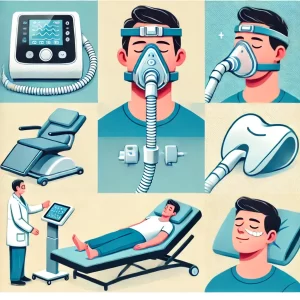
Lifestyle Changes for Sleep Apnea
Before diving into medical treatments, it’s important to recognize that certain lifestyle changes can significantly reduce the severity of sleep apnea symptoms.
For many people, addressing lifestyle factors is a crucial first step in managing sleep apnea.
Weight Loss
Obesity is one of the most significant risk factors for obstructive sleep apnea (OSA). Excess weight can contribute to the narrowing of the airway, making it more likely to collapse during sleep.
Losing weight can reduce the amount of tissue in the throat, which can help prevent airway obstruction.
Avoiding Alcohol and Sedatives
Alcohol and sedatives relax the muscles in the throat, which can exacerbate sleep apnea by increasing the likelihood of airway collapse.

Reducing alcohol consumption, especially before bed, can help reduce the frequency of apneas.
Sleeping Position
Sleeping on your back can worsen sleep apnea symptoms because gravity pulls the tongue and soft tissues toward the back of the throat, increasing the chances of airway blockage.
Side sleeping is generally considered the best position for people with sleep apnea, as it helps keep the airway open.
CPAP Therapy: The Gold Standard
For many people with moderate to severe sleep apnea, CPAP therapy is the most effective treatment.
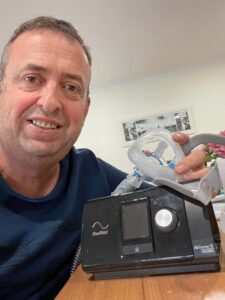
CPAP machines work by delivering a continuous stream of air through a mask, keeping the airway open throughout the night.
How CPAP Works
CPAP machines use a pump to generate air pressure, which is delivered through a hose and mask to the patient.
The constant pressure prevents the airway from collapsing, allowing for uninterrupted breathing during sleep.
CPAP Pressure Settings
CPAP machines have adjustable pressure settings, which are usually determined during a sleep study.
The right pressure setting ensures that the airway remains open without causing discomfort.
Some machines, such as APAP (Auto-Adjusting Positive Airway Pressure) machines, automatically adjust the pressure throughout the night based on the user’s needs.
CPAP Masks
There are several types of CPAP masks available, including:
- Nasal masks: Cover the nose and are ideal for people who breathe through their nose while sleeping.
- Full-face masks: Cover both the nose and mouth, making them a good option for people who breathe through their mouth or have nasal congestion. That’s me!
- Nasal pillow masks: Rest at the nostrils and are a more lightweight and minimal option.
Benefits of CPAP Therapy
CPAP is highly effective in reducing apnea episodes and improving sleep quality.
It also helps lower the risk of complications associated with untreated sleep apnea, such as high blood pressure and heart disease.
Oral Appliances: Mouthpieces for Sleep Apnea
For people with mild to moderate sleep apnea, oral appliances (also known as mouthpieces) can be a viable alternative to CPAP therapy.
These devices are custom-made by a dentist and work by repositioning the jaw or tongue to keep the airway open during sleep.
Mandibular Advancement Devices (MADs)
Mandibular advancement devices (MADs) are the most common type of oral appliance for sleep apnea. They work by pushing the lower jaw forward, which helps prevent the tongue and soft tissues from collapsing into the airway.
Tongue Retaining Devices (TRDs)
Tongue-retaining devices (TRDs) hold the tongue in a forward position, preventing it from blocking the airway. These devices are particularly useful for people whose sleep apnea is caused by the tongue falling backward during sleep.
Benefits of Oral Appliances
Oral appliances are less bulky than CPAP machines and are easier to travel with. They are also more comfortable for some people, especially those who have difficulty adjusting to CPAP masks.
Surgical Options for Sleep Apnea
For people with more severe sleep apnea or those who do not respond to CPAP or oral appliances, surgery may be an option. Several surgical procedures are available to treat the underlying causes of sleep apnea.
Uvulopalatopharyngoplasty (UPPP)
UPPP is one of the most common surgeries for sleep apnea. It involves removing excess tissue from the throat, including the uvula, soft palate, and tonsils, to widen the airway and reduce obstructions.
Genioglossus Advancement (GA)
This procedure repositions the genioglossus muscle, which controls the movement of the tongue. By moving the muscle forward, this surgery helps prevent the tongue from collapsing into the airway during sleep.
Maxillomandibular Advancement (MMA)
MMA is a more complex surgery that involves repositioning both the upper and lower jaws to enlarge the airway. This procedure is typically reserved for people with severe sleep apnea who have not responded to other treatments.
Inspire Therapy
Inspire therapy is a newer treatment that involves implanting a device in the chest that stimulates the hypoglossal nerve to keep the airway open during sleep. The device is activated by a small remote before bed and adjusts based on the patient’s breathing patterns.
Positional Therapy
For individuals whose sleep apnea is position-dependent (meaning their apneas worsen when they sleep on their back), positional therapy can be an effective treatment. The goal of positional therapy is to encourage side sleeping, which helps keep the airway open.
Positional Devices
There are several types of positional devices available, including:
- Positional belts: Worn around the waist to prevent the person from rolling onto their back.
- Vibrating devices: These small devices are worn on the back and vibrate when the person rolls onto their back, encouraging them to return to side sleeping.
Specialized Pillows
Special pillows, such as wedge pillows or side-sleeping pillows, can help keep the body in a position that reduces airway obstruction. These pillows provide support and elevation, making it easier to stay on your side throughout the night.
Adjustable Beds for Sleep Apnea
Adjustable beds can be a helpful addition to sleep apnea treatment by allowing the user to sleep in an elevated position. Elevating the upper body helps reduce airway obstruction by preventing the tongue and soft tissues from collapsing into the throat.
Benefits of Adjustable Beds
- Reduces snoring: By keeping the head and chest elevated, adjustable beds help prevent snoring, a common symptom of sleep apnea.
- Improves airflow: Elevating the upper body improves airflow and reduces the likelihood of apneas.
- Customizable comfort: Adjustable beds allow users to find the most comfortable sleeping position, which can enhance overall sleep quality.
Using Wedge Pillows
If an adjustable bed isn’t an option, wedge pillows can provide similar benefits. These pillows elevate the head and upper body, helping to reduce airway obstruction and snoring.
Alternative Therapies for Sleep Apnea
In addition to the traditional treatments, some alternative therapies have been explored for managing sleep apnea.
Acupuncture
Some studies suggest that acupuncture may help improve respiratory function in people with sleep apnea by stimulating certain pressure points. While acupuncture is not a replacement for CPAP or other treatments, it may serve as a complementary therapy for those seeking holistic approaches.
Weight Management Programs
Weight loss programs, including those that combine diet and exercise, are highly recommended for individuals with sleep apnea, especially those who are overweight or obese. Losing weight can reduce the severity of sleep apnea and, in some cases, eliminate the need for CPAP therapy.
Conclusion: Finding the Right Treatment for Sleep Apnea
Finding the right treatment for sleep apnea often requires a personalized approach, combining different methods to suit your unique needs. In my own experience with severe sleep apnea.

I found that using a CPAP machine with a full-face mask has been life-changing. It took some time to get used to the machine, but once I did, the improvement in my energy levels and overall health was undeniable. My migraines disappeared, and the difference in my sleep quality was remarkable.
However, I understand that CPAP isn’t the perfect solution for everyone. Some people find success with oral appliances, while others benefit from making simple lifestyle changes, like adjusting their sleep position or investing in an adjustable bed.
I’ve personally found that sleeping on my side helps keep my airway open, especially when using my full-face mask, which fits well even in this position.
No matter what treatment works best for you, it’s crucial to find a solution that fits your lifestyle and provides relief from the effects of sleep apnea.
Whether it’s through CPAP, mouthpieces, adjustable beds, or a combination of therapies, managing sleep apnea is possible with the right approach and support from a healthcare professional.
Thanks for taking the time to read my sleep apnea treatment guide. If you have any questions, please let me know below in the comments section.
